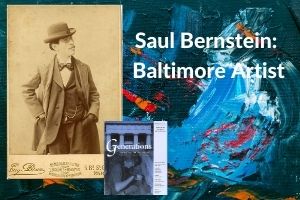From the Collection: Saul Bernstein, Baltimore Artist

 Written by Jobi Okin Zink, former JMM collections manager. Originally published in Generations – Winter 2001.
Written by Jobi Okin Zink, former JMM collections manager. Originally published in Generations – Winter 2001.
Visitors to Framing the Collections [on view May 6, 2001 – July 31, 2002], an exhibition that highlights the diverse holdings of the Jewish Museum of Maryland, might not immediately notice the self-portrait of artist Saul Bernstein (1872 – 1905). It is a small painting in a simple frame nestled among dozens of other portraits hung salon-style along the gallery walls. Many of its neighbors are large, imposing, and ornately framed; however, visitors who take time to step close to the artist’s self-portrait will find themselves intrigued by the depth and complexity of Bernstein’s expression.

Bernstein’s self-portrait, reminiscent of a 17th-century Dutch miniature, demonstrates his ability to paint a variety of textures in great detail. The small 5 ½ inch x 4 ¼ inch canvas draws the visitor close to the painting, creating an intimate link between sitter and viewer. Bernstein looks directly at the viewer from behind his small round glasses. His direct gaze captures and holds attention, challenging the viewer to understand who the artist was and what he was thinking. From the portrait alone, the Museum visitor can discern that Bernstein was well-dressed without being showy, honest, and forthright. The artist captures a hint of reflection across his wire-frame glasses and the full, wiry texture of his moustache, which is just a shade more golden than his light brown hair. The crisp white collar of Bernstein’s shirt contrasts with the soft wool of his vest and dimpled hat. His cheeks are flushed, but he has remained true to himself by adding the birth mark to his cheek. The thirty-three year old Bernstein added an inscription to the upper right corner of his self-portrait, “to my dear friend, Miss Henrietta Szold,” and signed his full name and the date, May 25, 1905.
Henrietta Szold was one of Bernstein’s greatest supporters, introducing his works to leading Baltimore art patrons and collectors. This painting was intended to be a gift from a grateful artist to his generous benefactor, but the artist died before it could be presented. Bernstein’s widow gave the painting to Miss Szold, who kept it in her collection for the rest of her life. It is only when we learn that Bernstein died an apparent suicide only two weeks after completing his portrait that the painting suggests hidden meanings. Is there a desperate plea in his intense gaze? Is Bernstein trying to convey a coded message?
Continue with Part 2: From Lithuania to Baltimore, publishing on June 3, 2019.
